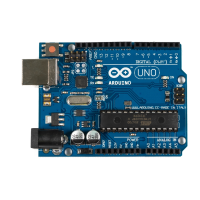digital metering ruler. Then you’ll use a three-axis accelerometer to build
your own motion-sensing game controller and a cool breakout game clone.
• At this point you’ve output data mostly using some LEDs and the Arduino’s
serial port. Now you’ll connect the Arduino to an actual TV set and gener-
ate your own video signals. You’ll create a graphical thermometer that
you can display on the TV set in your living room.
• In electronics, you don’t necessarily have to build gadgets yourself. You
can also tinker with existing hardware, and you’ll see how easy it is to
take full control of Nintendo’s Wii Nunchuk so you can use it in your own
applications. Soon, you’ll have everything you need to build your own
video game console.
• The Arduino does not have to work in isolation, and it works great with
different networking technologies. You’ll connect the Arduino to the
Internet in various ways, and you’ll learn how to send Twitter messages
and emails. You’ll build a burglar alarm that sends you an email whenever
someone is moving in your living room during your absence.
• Using a Nunchuk to control applications or devices is handy, but often
it’s more convenient to have a wireless remote control. So, you’ll learn
how to build your own universal remote control that you can even control
using a web browser.
• Finally, you’ll work with motors by creating a fun device for your next
software project. You can connect it to your continuous integration system,
so whenever the build fails, it will move an arrow to point to the name of
the developer who is responsible.
• In the appendixes, you’ll learn about the basics of electricity and soldering.
You’ll also find advanced information about programming a serial port
and programming the Arduino in general. And you’ll find an appendix
that explains how to control the Arduino using a web browser.
Every chapter starts with a detailed list of all the parts and tools you need to
build the chapter’s projects. All chapters contain lots of photos and diagrams
showing how everything fits together. You’ll get inspired by descriptions of
real-world Arduino projects in sidebars throughout the book.
Things won’t always work out as expected, and debugging circuits can be a
challenging task. So in every chapter, you’ll find a “What If It Doesn’t Work?”
section that explains the most common problems and their solutions.
report erratum • discuss
What’s in This Book • xv
www.it-ebooks.info

